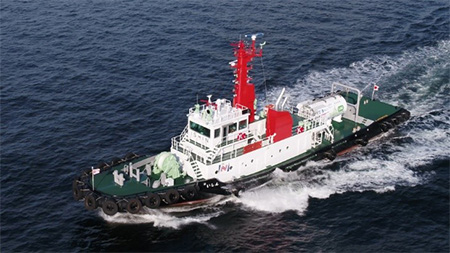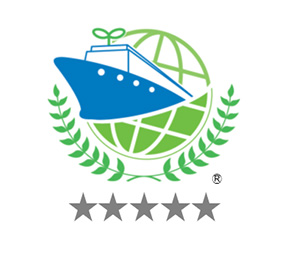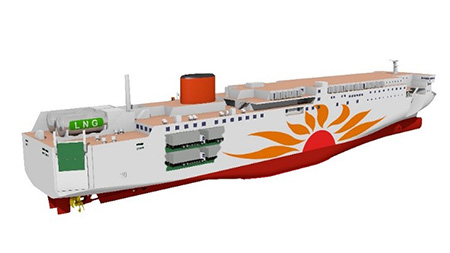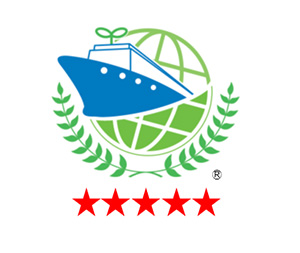- JP
- EN
LNG-fueled Ishin, Sunflower Kurenai and Sunflower Murasaki Earn Top Energy Conservation Rating for Japanese Coastal Ships
July 15, 2020

TOKYO-Mitsui O.S.K. Lines, Ltd. (MOL; President & CEO: Junichiro Ikeda) today announced that three MOL Group vessels-the LNG-fueled tugboat Ishin and the ferries Sunflower Kurenai (Note 1) and Sunflower Murasaki (Note 1) -have earned the top rating of five stars from the Japanese Ministry of Land, Infrastructure, Transport and Tourism (MLIT)'s energy conservation rating system for coastal ships (Note 2). The rating is based on LNG-fueled ships environmental performance, specifically a reduction of more than 20% in emissions of carbon dioxide (CO2) compared to vessels powered by conventional heavy oil.
The Ishin, owned by MOL and operated by its group company Nihon Tug-Boat Co., Ltd., (President: Tetsuro Nishio, headquarters: Chuo-ku, Kobe)and Japan's first LNG-fueled ferries-the Sunflower Kurenai (Note 2) and Sunflower Murasaki (Note 2) - are under construction and slated for operation by Ferry Sunflower Limited (President: Mitsujiro Akasaka; Headquarters: Oita-shi, Oita Prefecture)
The three vessels had already earned the highest rating of four stars under the ministry's temporary rating system, and with the system in full operation, have once again received top honors.
The Ishin (Note 3), the first LNG-fueled ship owned by MOL, is in operation and building a solid track record as the first LNG-fueled tugboat serving Osaka Bay. MOL also promotes the wider use of LNG as a marine fuel as a forerunner in the trend toward LNG-fueled ships, for example, by cooperating in LNG fuel supply trials in the ports of Kobe and Nagoya. (Notes 4, 5)
The Sunflower Kurenai and Sunflower Murasaki are slated for launching from the end of 2022 through the first half of 2023 on the Ferry Sunflower-operated Osaka-Beppu route as an alternative to existing vessels. (Note 6)
The MOL Group sets "Promotion of environmental strategies and development of the emission-free business into a core business" as a core strategy in its Rolling Plan 2020 management plan. The group continually develops technologies for LNG-fueled ships and strives to reduce the environmental impact of its operations.


Outline of Ishin
Gross tonnage: 247 tons
Length: 43.6 m
Breadth: 9.20 m
Draft: 3.15 m
Speed: 16.4 knots (max. output)
Main engines: 2 Yanmar 6EY26DF dual-fuel commercial marine engines


Outline of Sunflower Kurenai, Sunflower Murasaki (propose)
Gross tonnage: 17,300 tons
Length: 199.9 m
Speed: 22.5 knots
Loading capacity (trucks): 136 units (in conversion with 13m)
(Note 1)
Ship names are subject to change.
(Note 2)
The program aims to "visualize" energy savings and the effects of 2 reduction in the vessel planning and design stages and objectively evaluate ships' energy-saving and CO2 reduction performance to foster the development of coastal ships that offer greater energy saving and CO2 reduction.
(Note 3)
Please refer to the September 28, 2018 press release:
LNG-fueled Tugboat Named Ishin -Earns Highest 4-star for Coastal Ship Energy Conservation Rating-
(Note 4)
Please refer to the September 18, 2019 press release:
LNG-fueled Tugboat Ishin Undergoes 1st LNG Bunkering Trial in Port of Kobe
- Contributing to Development of LNG Bunkering Ports and Wider Use of LNG as Marine Fuel –
(Note 5)
Please refer to the November 8, 2019 press release:
1st LNG Bunkering in Nagoya Port
- Developing an LNG Fuel Supply Terminal and Promoting the Use of Natural Gas –
(Note 6)
Please refer to the November 20, 2019 press release: MOL Group to Build Japan's 1st LNG-fueled Ferries: Sunflower Kurenai and Sunflower Murasaki
